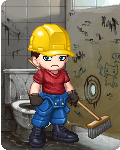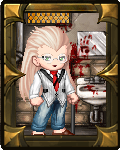:: Liberty quickly spreads her papers out, facing away from her, then jabs a finger at the circle she's numbered 83 ::
But, what about this? It either is a square or its two vertical lines - evenly spaced - combined with the horizontal longer pair of parallel lines.
It also appears in 93, 107, 145, 156, and 162.
:: she pauses, looks down, and up again::
I think. I've been debating if its vertical parallels or a box, but I really think those vertical lines are perfectly straight and therefore an additional symbol. See, this one
:: she pokes #81 ::
has that very slight outward curve. Compare it to the one in 83. No curve, no matter how much I squint. And I have squinted. Several times.
Also
:: She pokes one paper forward with her finger, then stabs at the circle numbered 37 ::
The circle in this one is bigger than the other large circles. Unless that's for emphasis, but I don't think it is. See, you can compare it to this circle
:: she pokes at circle #34 ::
Or this one
:: she pokes circle # 43 ::
which are all represented to the same scale and the one in 37 is bigger. It isn't an optical illusion.
What you've translated seems to work and it supports your theory but I think there are 28 symbols, not 26. See?
:: she spreads her fingers, indicating the two papers marked at the top "Base Elements"::
(( attached ; Sorry they're small - size limit on attachments) ))
I was trying to figure out why there are 3 symbols that stand alone
:: she points ::
2, 8, and 24. The one I numbered 2 is alone in circles 66 and 71. Number 8 is alone in 91 and number 24 is alone in 140. I started thinking it was a triple code, which would explain the 28 symbols.
If you can see something I can't I'm fine with that, but...
:: shrug ::
yeah. I want to be on board with your translation but...
:: she waves at the notes ::
Charcoal rubbings
21 posts
• Page 2 of 3 • 1, 2, 3
Re: Charcoal rubbings
- Attachments
-
- OR Code Base Elements 2b.jpg (79.37 KiB) Viewed 12157 times
-
- OR Code Base Elements 1b.jpg (82.04 KiB) Viewed 12157 times
Liberty Blue
aka kim
aka kim
-

kimp - Posts: 206
- Joined: Wed May 15, 2013 1:35 am
Re: Charcoal rubbings
A low, pleasantly whistled show tune proceeds the friendly janitor as walks through the dinner where people are discussing things. Unaware of the topic of discussion he walks over to the group and give them a friendly smile and nod.
"Hey guys, what cha working on? kinda looks like a cross word puzzle. Or is it one of those fancy So-doke-koos?"
He says brushing his dirty hands on his red flannel shirt.
"Hey guys, what cha working on? kinda looks like a cross word puzzle. Or is it one of those fancy So-doke-koos?"
He says brushing his dirty hands on his red flannel shirt.
"Killing a thing doesn't make you a monster. Killing a thing that don't need killing makes you a monster."
-

ronfiction - Posts: 199
- Joined: Tue Jun 11, 2013 1:12 pm
- Location: Manchester NH
Re: Charcoal rubbings
- Power Plant Key.jpg (74.32 KiB) Viewed 12146 times
O: Two horizontal Lines (longer and closer than E)
P: Outward Brackets
E: Two horizontal lines (spread far)
N: X
The Square is made up of the Brackets that form P and the Lines that form O. The lines at the very top and bottom are for the E.
The P is on it's own on page 9, the only one in the 2nd row. I think you'd call it #136. That is the first part of the word BYPASS, with the next S as #140. The top of the bracket gets lost in #83 with the horizontal lines that form the O.
#81 is different. It is LOCKD, continued in #85 to form LOCKDOWN. I call it L, outward parenthesis, shallow.
L: Outward Parenthesis, shallow
O: Two horizontal Lines (longer and closer than E)
C: Spear (point up)
K: Almost an X, top and bottom
D: Line (top and bottom have caps)
#81 is tricky for two reasons. First, look close, the X does not meet at the middle, making it different from #83. Second, there are two vertical symbols on top of each other. One is C, the Spear, which you can see more clearly on Page 2, 3rd on the top, #19. It has a bump in the middle, but the top is a point. But #81 has a cap on the point, meaning that there is also D, Line there. You can see D more clearly on #18 or #23, both also on Page 2.
For circles, #37 is the first half of QUEEN, or QUE. The second half is #41.
Q: Large circle
U: small circle
E: Two horizontal lines (spread far)
#34 is the first half of THREE, or THRE. The second half is #37.
T: Large V
H: Parenthesis
R: Medium circle
E: Two horizontal lines (spread far)
Those two give us examples of our three single circles, Q, R, and U.
The stand alone symbols are:
L: Outward Parenthesis, shallow.
Which you call 2. Read the symbols from top to bottom, starting at the left. Two symbols in a row combine to form a word, otherwise there is a space. Symbol #77 is AL, followed by Symbol #66, L, so that word is ALL. Symbol #67 is WIL, followed by Symbol #71, L, so that word is WILL.
A: Tee-pee
Which you call 8. This is the only actual stand-alone letter, as there is an empty circle above it and below it at symbol #91. It is also symbol #113.
S: Two small circles, vertical
Which you call 24. Symbol #140 is the second half of Symbol #136, which I mentioned above. #136 is BYPAS and #140 is S, to form BYPASS.
When the same letter appears twice in a word, it isn't always broken into two symbols, but it often is. EVENT, VESSEL, and HATCH all seem to be one symbol, appearing to me as VENT, HATC, and VESL.
Last edited by lackey on Tue Jun 09, 2015 4:07 pm, edited 1 time in total.
Ed
-

lackey - Posts: 22
- Joined: Fri Jan 31, 2014 1:34 pm
Re: Charcoal rubbings
Hey Lou.
Just deciphering the panel at the bottom of the Power Plant. Looks like those giant bugs were a sophisticated alien race looking to plunder earth. They call their space ship "EXPILATOR", which means one who plunders. Or at least that's how it looks to me.
Just deciphering the panel at the bottom of the Power Plant. Looks like those giant bugs were a sophisticated alien race looking to plunder earth. They call their space ship "EXPILATOR", which means one who plunders. Or at least that's how it looks to me.
Ed
-

lackey - Posts: 22
- Joined: Fri Jan 31, 2014 1:34 pm
Re: Charcoal rubbings
Madrigus passes by in time to hear Ed's last comment. "Huh, 'Expilator' doesn't have the same ring to it as 'Excelsior' does." He leers for a moment and drifts back to things he understands.
"Desperation will turn any mortal to the darkest secrets hidden in the darkest vaults."
-Madrigus (Brendan)
[*Deadbolt from Lost Eidolons]
Point Total: 2,650
-Madrigus (Brendan)
[*Deadbolt from Lost Eidolons]
Point Total: 2,650
-

Madrigus - Posts: 408
- Joined: Thu Nov 29, 2012 2:02 am
Re: Charcoal rubbings
Lou blinks a few times; the happy smile on his face fading. He fights back the urge to disbelieve what he has heard. He looks around the dinner for a second and then lowers his voice some.
"Maybe you folks shouldn't be talking about this in the dinner."
He says and nervously looks around to see if locals or out of tonwers were around.
"Maybe you folks shouldn't be talking about this in the dinner."
He says and nervously looks around to see if locals or out of tonwers were around.
"Killing a thing doesn't make you a monster. Killing a thing that don't need killing makes you a monster."
-

ronfiction - Posts: 199
- Joined: Tue Jun 11, 2013 1:12 pm
- Location: Manchester NH
Re: Charcoal rubbings
*The Professor looks up*
"Hey Lou! How goes the plan for getting you a Silver level Health plan?"
Turning to Billie
"Don't worry. I have........ this taped up on the wall in Flo's back room. The one...... I normally run my free therapy clinic out of. Since my....... shop is temporarily closed, it's only people back here that I let back here. I agree..... we may not want regular townfolk worried about it. Though the Sheriff did wander by asking something about popcorn"
*Knocking his pipe against the seat, he puts it back between his teeth. No one has ever seen him light the thing though*
"Ed, some........ damn fine points there. You have..... a knack for this. Liberty, good...... work sorting through all of this."
"Hey Lou! How goes the plan for getting you a Silver level Health plan?"
Turning to Billie
"Don't worry. I have........ this taped up on the wall in Flo's back room. The one...... I normally run my free therapy clinic out of. Since my....... shop is temporarily closed, it's only people back here that I let back here. I agree..... we may not want regular townfolk worried about it. Though the Sheriff did wander by asking something about popcorn"
*Knocking his pipe against the seat, he puts it back between his teeth. No one has ever seen him light the thing though*
"Ed, some........ damn fine points there. You have..... a knack for this. Liberty, good...... work sorting through all of this."
Kevin
-Character: Douglas Rook
-Formerly known as Professor John Challenger
-Position: Rook for The Lady in White
"Time to feed the Crows"
-Character: Douglas Rook
-Formerly known as Professor John Challenger
-Position: Rook for The Lady in White
"Time to feed the Crows"
-

Tesla - Posts: 360
- Joined: Sun Dec 30, 2012 7:38 pm
- Location: Lowell, MA
Re: Charcoal rubbings
:: Liberty lifts her brows slightly ::
What are you suggesting? I'm just doing a puzzle.
:: Her lips quirk slightly ::
Which I do often here. Along with playing with toys and building towers out of kitchen items.
:: she lowers her voice to a conspiratorial level ::
Don't tell Flo about that last one.
:: she makes a show of straightening the ridiculous volume of her notes, flipping them face down on the table, then leans towards Ed to say in a low voice ::
I'm not sure that word is lockd-own. Unless the D and C symbols are on top of each other?
:: she frowns. ::
Which would explain the slight bump in the center of that bar.
:: she goes quiet for a moment staring unblinking at the wall then cisibly refocuses ::
If it isn't lockd-own I'm thinking it could be Blood. Long horizontals are O. Vertical line with two end caps is D. Shallow outward parens is L. And the deep parens from top and bottom, which I call X not X is B. Double the O and you have blood. Because circles 105 and 139 are the same symbol pattern but aren't followed by OWN.
The fragmented quality of the words and syntax hurt my brain, and I'm not sure why Ion would follow Blood but.
:: she shrugs ::
Otherwise you and I broke it down close to the same.
But I do wonder if there is a code in the code. The amount of numbers mentioned tweaks my mind. I once did a puzzle that involved solving 30 plus other puzzles, taking the answers to those puzzles and connecting them in a long string of word associations, then breaking the letters in the words down into their numerical values to get a 3 digit numerical code to unlock a combination lock.
I'm not saying that's what this puzzle involves but I still question the inclusion of so many numbers. Maybe they are just the key built into the code, getting two and eight helped me figure out many of the other symbols, or maybe there's more to it.
What are you suggesting? I'm just doing a puzzle.
:: Her lips quirk slightly ::
Which I do often here. Along with playing with toys and building towers out of kitchen items.
:: she lowers her voice to a conspiratorial level ::
Don't tell Flo about that last one.
:: she makes a show of straightening the ridiculous volume of her notes, flipping them face down on the table, then leans towards Ed to say in a low voice ::
I'm not sure that word is lockd-own. Unless the D and C symbols are on top of each other?
:: she frowns. ::
Which would explain the slight bump in the center of that bar.
:: she goes quiet for a moment staring unblinking at the wall then cisibly refocuses ::
If it isn't lockd-own I'm thinking it could be Blood. Long horizontals are O. Vertical line with two end caps is D. Shallow outward parens is L. And the deep parens from top and bottom, which I call X not X is B. Double the O and you have blood. Because circles 105 and 139 are the same symbol pattern but aren't followed by OWN.
The fragmented quality of the words and syntax hurt my brain, and I'm not sure why Ion would follow Blood but.
:: she shrugs ::
Otherwise you and I broke it down close to the same.
But I do wonder if there is a code in the code. The amount of numbers mentioned tweaks my mind. I once did a puzzle that involved solving 30 plus other puzzles, taking the answers to those puzzles and connecting them in a long string of word associations, then breaking the letters in the words down into their numerical values to get a 3 digit numerical code to unlock a combination lock.
I'm not saying that's what this puzzle involves but I still question the inclusion of so many numbers. Maybe they are just the key built into the code, getting two and eight helped me figure out many of the other symbols, or maybe there's more to it.
Liberty Blue
aka kim
aka kim
-

kimp - Posts: 206
- Joined: Wed May 15, 2013 1:35 am
Re: Charcoal rubbings
Code within a Code.... You may have something there. I don't know really what the borders mean, and there are some quirks including all of the numbers.
And we need to figure out the Authorization code.
Border 1 Words
HIVE
VESSEL
SWARM
QUEEN
HATCH
EVENT
EMERGENCY
HATCHES
LOCKDOWN
POSITION
COMPUTER
MATRIX
AUTHORIZATION
CODE
OPENING
PRESSURE
Border 2 Words
COMMAND
ENTER
OPEN
REBOOT
ENTER
STAND
PREVENT
INJURY
DEPONSATION (or whatever that word is supposed to be)
Border 3 Words
TWO
FOUR
EXPILATOR (If this is right,...)
ON
EIGHT
UNDER
LEAST
THREE
SIX
EMERGENCY (Once here, twice with Border 1)
FIVE
ALL
WILL
DEFAULT
CLEAR
BYPASS
POTENTIAL
No Border Words
THE
OF
IN
AN
TO
A
DURING
AND
DUE
So the borders could be for types of words. Nouns, Verbs, Adjectives + Numbers, and Prepositions. One use of EMERGENCY is as an adjective for HATCH, the other uses may be the noun form...
Then the numbers... Leaving out everything else, the numbers given are:
2 4
8 4 2 2
3 6
5 2 5
And we need to figure out the Authorization code.
Border 1 Words
HIVE
VESSEL
SWARM
QUEEN
HATCH
EVENT
EMERGENCY
HATCHES
LOCKDOWN
POSITION
COMPUTER
MATRIX
AUTHORIZATION
CODE
OPENING
PRESSURE
Border 2 Words
COMMAND
ENTER
OPEN
REBOOT
ENTER
STAND
PREVENT
INJURY
DEPONSATION (or whatever that word is supposed to be)
Border 3 Words
TWO
FOUR
EXPILATOR (If this is right,...)
ON
EIGHT
UNDER
LEAST
THREE
SIX
EMERGENCY (Once here, twice with Border 1)
FIVE
ALL
WILL
DEFAULT
CLEAR
BYPASS
POTENTIAL
No Border Words
THE
OF
IN
AN
TO
A
DURING
AND
DUE
So the borders could be for types of words. Nouns, Verbs, Adjectives + Numbers, and Prepositions. One use of EMERGENCY is as an adjective for HATCH, the other uses may be the noun form...
Then the numbers... Leaving out everything else, the numbers given are:
2 4
8 4 2 2
3 6
5 2 5
Ed
-

lackey - Posts: 22
- Joined: Fri Jan 31, 2014 1:34 pm
21 posts
• Page 2 of 3 • 1, 2, 3
Who is online
Users browsing this forum: No registered users and 1 guest
